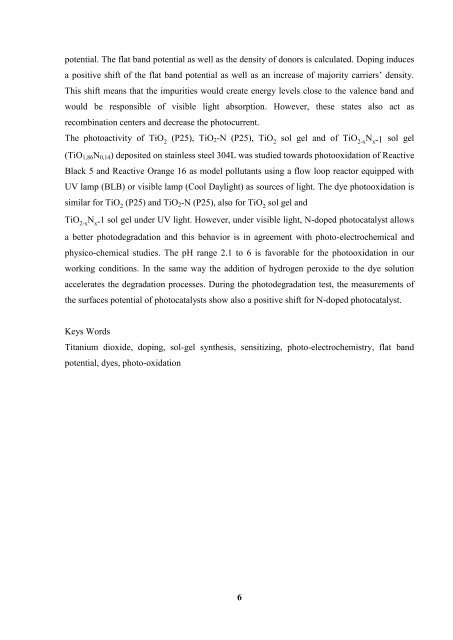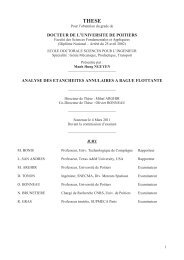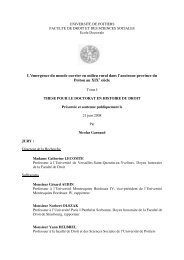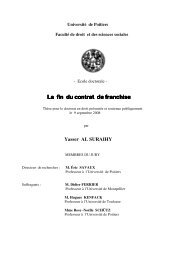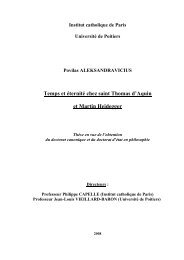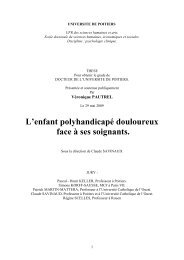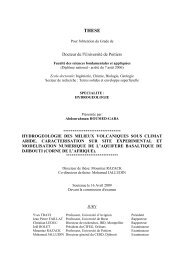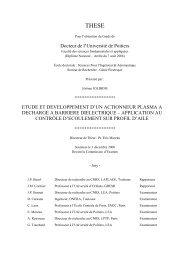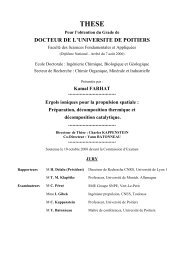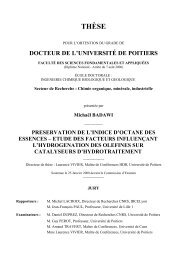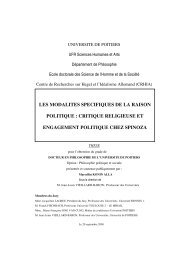Consulter le texte intégral de la thèse - Université de Poitiers
Consulter le texte intégral de la thèse - Université de Poitiers
Consulter le texte intégral de la thèse - Université de Poitiers
Create successful ePaper yourself
Turn your PDF publications into a flip-book with our unique Google optimized e-Paper software.
potential. The f<strong>la</strong>t band potential as well as the <strong>de</strong>nsity of donors is calcu<strong>la</strong>ted. Doping induces<br />
a positive shift of the f<strong>la</strong>t band potential as well as an increase of majority carriers’ <strong>de</strong>nsity.<br />
This shift means that the impurities would create energy <strong>le</strong>vels close to the va<strong>le</strong>nce band and<br />
would be responsib<strong>le</strong> of visib<strong>le</strong> light absorption. However, these states also act as<br />
recombination centers and <strong>de</strong>crease the photocurrent.<br />
The photoactivity of TiO 2 (P25), TiO2-N (P25), TiO 2 sol gel and of TiO 2-x N x-1 sol gel<br />
(TiO1,86N0,14) <strong>de</strong>posited on stain<strong>le</strong>ss steel 304L was studied towards photooxidation of Reactive<br />
B<strong>la</strong>ck 5 and Reactive Orange 16 as mo<strong>de</strong>l pollutants using a flow loop reactor equipped with<br />
UV <strong>la</strong>mp (BLB) or visib<strong>le</strong> <strong>la</strong>mp (Cool Daylight) as sources of light. The dye photooxidation is<br />
simi<strong>la</strong>r for TiO 2 (P25) and TiO2-N (P25), also for TiO 2 sol gel and<br />
TiO 2-x N x-1 sol gel un<strong>de</strong>r UV light. However, un<strong>de</strong>r visib<strong>le</strong> light, N-doped photocatalyst allows<br />
a better photo<strong>de</strong>gradation and this behavior is in agreement with photo-e<strong>le</strong>ctrochemical and<br />
physico-chemical studies. The pH range 2.1 to 6 is favorab<strong>le</strong> for the photooxidation in our<br />
working conditions. In the same way the addition of hydrogen peroxi<strong>de</strong> to the dye solution<br />
acce<strong>le</strong>rates the <strong>de</strong>gradation processes. During the photo<strong>de</strong>gradation test, the measurements of<br />
the surfaces potential of photocatalysts show also a positive shift for N-doped photocatalyst.<br />
Keys Words<br />
Titanium dioxi<strong>de</strong>, doping, sol-gel synthesis, sensitizing, photo-e<strong>le</strong>ctrochemistry, f<strong>la</strong>t band<br />
potential, dyes, photo-oxidation<br />
6


